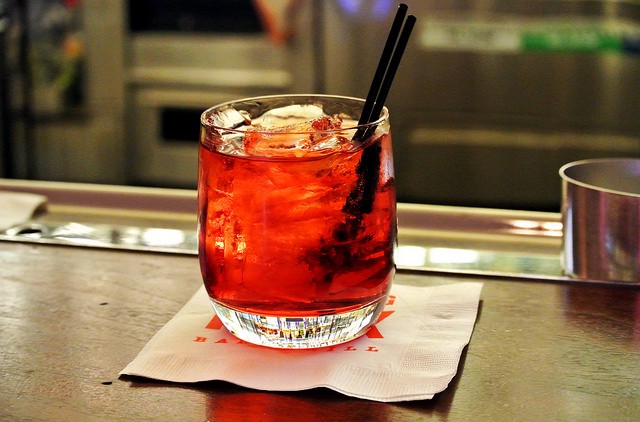Negroni Weak

On Monday, it will once again be Negroni Week. (This is not to be confused with Negroni Season, which is a state of mind, not a time of year.) Hashtag Negroni Week is a recent invention of Imbibe magazine that has since been wholly co-opted by advertising executives and branding consultants employed by Campari America, a subsidiary of the Campari Group, a large corporation that sells, among other things, Wild Turkey whiskey, SKYY Vodka, and its namesake aperitif. Campari is a pink, bitter liqueur, and the signature ingredient in the Negroni, a cocktail that has, in recent years, been adopted by preening gadflys who would like to portray themselves as sophisticated drinkers with a highly discerning palate that allows them to enjoy beverages that are “bitter forward”:
The subtext of the discussion at this mythical world’s-most-awful bar, which might actually exist on the Internet, is that anyone who enjoys negronis has an incredibly distinguished palate which allows them to fully enjoy negronis in a way that most people can’t appreciate. One person told the Times that the negroni is “a sophisticated cocktail, too, for an audience that appreciates the cocktail and the story behind it.” Bon Appetit described the negroni at one point as “a secret handshake, a sign to bartenders that you knew what you liked, and how to order it.” Serious Eats calls it “a serious drink for serious drinkers.” GQ says, “A Negroni, like black coffee or Texas, is an acquired taste.”
Never mind that there are now frozen Negronis.
The most terrible thing about Negroni Week is not that it will encourage these people to come out en masse to drink Negronis and tell you about how they’re drinking Negronis and that you should also drink Negronis, but that Negroni Week, which began as a fairly off-the-cuff charity drive, is now a full-blown marketing event heavily dressed in a booze-soaked garb of philanthropy when it is engineered to do little more than move bottles of Campari.
Bars and restaurants who sign up to participate in Negroni Week agree to “donate $1 (or more) from each one sold to a charity of their choice from June 1–7.” Whichever establishment raises the most money will see an additional ten thousand dollars donated to the charity of its choice by the Campari Group. This is charitable enough on the part of these establishments, especially the ones donating more than the minimum dollar per drink (or foodstuff); most bars and restaurants, especially in cities like New York and San Francisco, survive on slim margins. But ten thousand dollars is a pittance for Campari. Especially when one considers that, according to the New York Times, last year, the Negroni Week campaign cost just under a million dollars.
The net result, according to the Negroni Week website, was “more than $120,000 raised for charities.”
Leaving aside that barely a tenth of the million dollars spent on last year’s campaign actually made it to charities, let’s do some cocktail-napkin math. (Which is hazardous for a number of reasons, not least that participating bars self-report their sales and donations to the organizers of Negroni Week.) Let’s be generous and conservative, and assume that the average amount donated per Negroni was two dollars, or that roughly sixty thousand Negronis were sold by the thirteen hundred bars that have participated in Negroni Week. While proportions (and ingredients) can vary, a classic Negroni contains one ounce of gin, one ounce of sweet vermouth, and one ounce of Campari, meaning that bars might have poured some sixty thousand ounces of Campari down people’s throats. A bottle of Campari is one liter, or 33.8 ounces, so a conservative estimate is that Negroni Week moved at least one thousand, seven hundred and seventy-five bottles of Campari. One bartender in Atlanta told me that the wholesale price per bottle, according to an inventory sheet that is “a few months old,” is twenty-eight dollars; it is markedly cheaper abroad. But given the variabilities of markets and distributor fees, let’s assume that Campari reaps just ten dollars per bottle. That would mean, through Negroni Week, Campari America sold, conservatively, nearly eighteen thousand dollars of Campari, or nearly double what it gave to charity. In other words, the cost of any of the actual charity is being borne entirely by the bars, which have to stock vast quantities of Campari to fulfill the demand artificially inflated by the false premise of good works.
Capitalist enterprises can very occasionally incidentally perform acts of charity. It’s not really charity, though, when the profit-seeking enterprise benefits far more from its charity than any of the causes to which it is supposedly being charitable. Negroni Week is perhaps one of those cases? But like whatever! Go ahead and drink a Negroni next week, if you want. You could even delude yourself into thinking that you are doing a Good Thing. Or you could drink something better — may I suggest something with Gran Classico Bitter, a vastly superior aperitif? — and give some money directly to charity. You know, do you.
Photo by mariobonifacio
